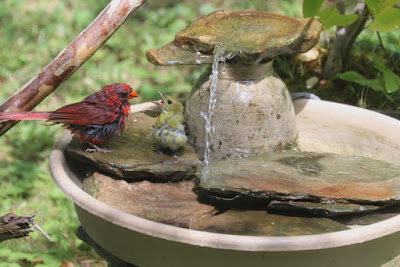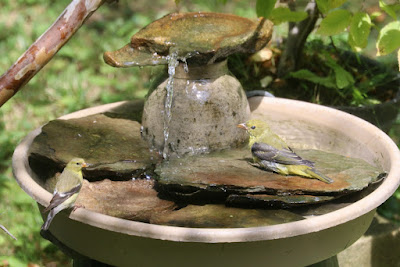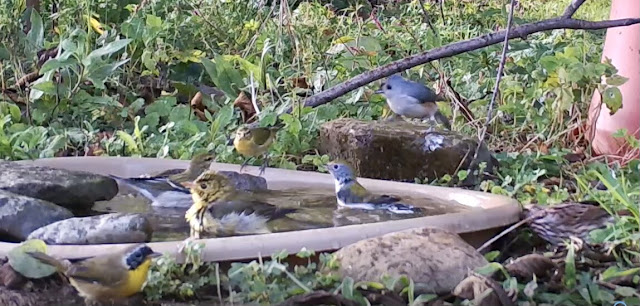On mornings when it's getting hot fast, I always give the WarblerFall a quick scrub. I change out the rocks to clean ones (all I have to do is leave them in the sun between cleanings, and its heat does my work for me!), scrub the basin with a Magic Eraser, and rinse and refill with clean water. It only takes a few minutes to make the bath fresh, clean and sparkling again. Thank you, Sun!
I knew there would be serious action today, August 21, with a humid high of 88.
Sure enough, along came a baby cardinal, a female.

She still has the blackish bill she was born with. She's likely still being fed by her parents.

She had such fun in the cool bath it wasn't long before her parents came to join her!
I was thrilled to get the whole family in one shot. That doesn't happen often.
The 'rents look considerably less fresh-faced than she does. Well, they've probably been feeding her for 50 days. I know. I've done it. Baby cardinals beg for forever, and then add a few weeks.

Mom Cardinal was down to the last two feathers in her crest. Maybe she pulled them out in frustration...

Anyway, I'm projecting. The little family was having a nice bath together, and it was Baby's idea.
Then someone new showed up, startling everyone!

It was a male scarlet tanager! Mom didn't mind. She was just happy to be able to take a bath without anyone clamoring at her for something.

Dad Cardinal made a classic dad move, rudely crowding the tanager, who protested with a little squeal.

The tanager, a juvenile male, held his own.

At length, the Cardinal family left, and the tanager was finally able to take a long soaker.
At one point a female American goldfinch joined him, looking like a mini-me!

Finally even the goldfinch left. Every time I looked out the window for the next ten minutes, the tanager was there, soaking. It was sweet to see him enjoy the bath so very much.
The WarblerFall got a nice shoutout last week on the Martha Stewart website!
They called to interview me and I had to tell them about the WarblerFall.
I sent them photos, but they didn't use them. The WarblerFall beats all the bird baths featured in the article by a country mile. I'm not bragging here. It just does. It's the best bird bath you can get. I've had 28 species in mine just this summer. My friend Briana at
The Hungry Little Birdie in Michigan hit 42 species for the summer today with a young Blackburnian warbler! I'm waiting for my friend and neighbor Laura to tally up her species. I think she'll blow us both out of the shallow pool. ***
see end of post for an update!
photo courtesy The Hungry Little Birdie
I got a SWEET pair of juvenile Kentucky warblers recently, though! The female arrived first and poked around the shade garden amid the ferns and pink Angelonia (a new favorite flower!)
And then she came to the WarblerFall!
soon to be joined by her splendid brother, here perched on a tomato cage. Oh man, I love this warbler. This pair were probably hatched and fledged just a few hundred yards away, in my orchard, where their handsome daddy scolded me every morning as I walked by their nest. I saw at least two fledglings being fed, and then along come these jewels on 27 July. My cup runneth over--KEWA was species #25 in the WarblerFall this summer.
The best part about the WarblerFall, after the ridiculous bird diversity it attracts, is that you make it yourself, and customize it to your liking.
But please take close note of the type of rock and shallow depth of the water in our creations.
I'd recommend getting your WarblerFall built as soon as you can, because fall migration is coming into full swing. Just ask that young tanager! Migrating is thirsty work, and warblers, tanagers, vireos and finches are delighted to find cool running water to bathe in on these hot, hot August days.
September is even better, and October holds such surprises! Kinglets, anyone?
Here's an update from my neighbor Laura, whose trail cameras capture the most outrageous things.
She's got two baths, one with a recirculating pump and one without. The classic WarblerFall with a pump has 43 species for this season, so she has edged me out by a long shot, and she has only one more than Briana in Michigan.
We'll start you off easy. Here is a photo from August 8, 2023.
An older female Baltimore oriole and a two-year-old rose-breasted grosbeak bathe together.
Here is Laura's trailcam photo from early July 2023. Not one, but FIVE blue-winged warblers consider a bath. This has to be a pair with their three fledglings. Can you stand it?
And the piece de resistance: SEVEN species at the bath at one time, 13 September 2022. From left, Laura identified them as common yellowthroat (male); scarlet tanager imm (big bird in front with pale bill); a bay-breasted warbler in the water behind the tanager; an imm. Tennessee warbler on the rim in back; an imm. chestnut-sided warbler in the water to the right; a tufted titmouse on the rock; and a song sparrow at the far right. I just squealed when I saw this. Thank you, Laura, for this insane clown posse of birds in your WarblerFall!
























0 comments:
Post a Comment